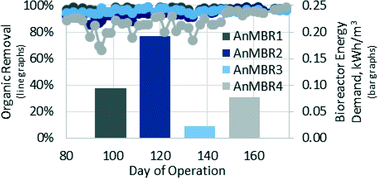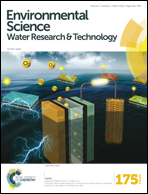Reduced energy demand for municipal wastewater recovery using an anaerobic floating filter membrane bioreactor
Abstract
Anaerobic membrane bioreactor (AnMBR) technology for municipal wastewater has shown great promise for achieving low energy, low carbon footprint treatment. However, one potential drawback to fixed-film systems such as fluidized-bed reactors (FBR) is the need for high recycle flow rates to fluidize biocarrier. These high recycle rates could diminish the significant energy savings achieved from eliminating activated sludge aeration. In this study 3.3 L FBR and downflow floating media filter (DFF) AnMBRs were fed a synthetic primary effluent at 10 and 25 °C and evaluated on the basis of organic removal and energy demands. Both FBR and DFF configurations achieved BOD5 < 8 mg L−1 at bioreactor hydraulic retention times (HRT) ranging from 4.2–9.8 h. The DFF bioreactor required 60–75% less recycle energy than the FBR bioreactor while achieving organic removal similar to FBR and conventional aerobic treatment at 10 and 25 °C. Additionally, DFF AnMBR biotechnology coupled with nutrient and dissolved methane removal technologies are estimated to require between 30 and 50% less energy compared to an activated sludge process.


 Please wait while we load your content...
Please wait while we load your content...